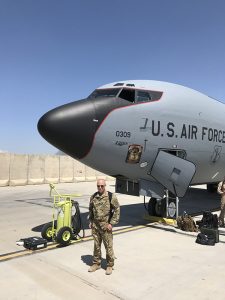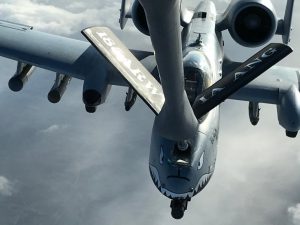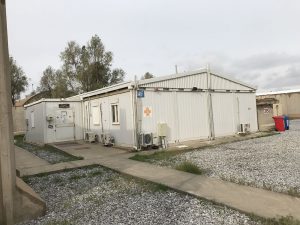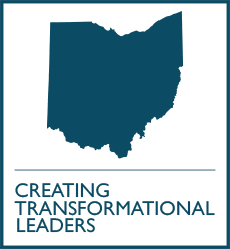May 14

The Perfect Marquinez: Stirred, Never Shaken
The comparisons of battling the COVID-19 pandemic to fighting an enemy during war seem endless. Perhaps the disease needs to be personified ― the way it infiltrates without being noticed; the manner with which it paralyzes you, disabling your freedom to move about as you normally would; the rate at which it can kill you.
Most of us have no idea of what war or being in the military is truly like. So, we accept these comparisons at face value.
But when you listen to Lieutenant Colonel (Lt. Col.) Frederick Marquinez, a member of the United States Air Force and the Ohio Air National Guard, you quickly realize that the comparisons are pretty accurate.
“Some of the strategies used in fighting conventional enemies are also used in the fight against pandemics, such as COVID-19,” says Lt. Col. Marquinez, who was serving in Kandahar, Afghanistan, when news came of the spreading threat. He is currently a medical oncologist/hematologist with UH Seidman Cancer Center-Portage Medical Center in Ravenna.
“They include containing the enemy and trying to identify its weaknesses; mobilizing troops to needed areas; identifying mission-essential and mission-critical personnel; and gathering intelligence.”
There’s also the need to maintain good lines of communication; to ensure good logistics to acquire and transport supplies and identify centers of gravity; and to keep some troops in reserve to be mobilized when the front-line troops become ineffective. Communications, logistics, supplies and people on the front lines ― sound familiar right?
A Battle Cry for Social Distancing
Though the novel solutions to win the war against COVID-19 have not been as widespread as the strategies to fight the battles, at least one tactic has proven effective: social distancing.
“The supreme art of war is to subdue the enemy without fighting.” ― Sun Tzu, The Art of War
Most would argue that public health, and the resulting “social distancing,” have been that non-contact, supreme art. Enemy subdued? Hardly. But are “we” winning the battle? Many would say that we are.
Yes, some new art such as “contact tracing” may become the next successful strategic approach as we move to the next phase of the war against this pandemic. But until the ultimate defense in the form of a vaccine is developed, our best weapon will be public health ― to the victor belong the spoils.
What spoils, one may ask?
This enemy ― COVID-19 ― knows something that we sometimes forget: We need to lean on each other. To be well. To continue to exist. This is our battle cry.
By practicing physical distancing, we take away the power of COVID-19 ― its capacity to spread. Its ability to exist.
But winning such a battle requires more than stripping the enemy of its weapons. Strategies need to be implemented. Teams need to be guided into action. And leaders need to be installed who are omnipresent, trustworthy, knowledgeable, proactive and unwavering.
Such battles call for leaders like Lt. Col. Fred Marquinez, who has served with extraordinary commitment in both medicine and the military.
Acting, Guiding and Sacrificing

“I have long been a history enthusiast, especially of medical and military history. Through reading and talking to many veterans over the years, I learned of and was grateful for the sacrifices by those who have served in the military,” says Lt. Col. Frederick Marquinez. He also has been inspired by his daughter Alyse, who served in the U.S. Coast Guard.
Stirred to action by his parent’s health professions ― dad was a family practice physician and mom, a nurse ― Marquinez quickly fulfilled his desire to serve in the medical field, a predestiny of sorts. Upon graduating from Walsh Jesuit High School, a private school in Cuyahoga Falls, Ohio, he enrolled in one of Northeast Ohio Medical University’s accelerated programs (formerly called the B.S./M.D. program) via the Kent State University/NEOUCOM partnership. Graduating from Northeast Ohio Medical University in 1985, Fred Marquinez became a physician at 24, joining such classmates as current College of Medicine dean Elisabeth Young, M.D., as some of the region’s brilliant young doctors.
Dr. Marquinez completed an internal medicine residency at St. Thomas Medical Center (now Summa Health-St. Thomas Campus) in Akron and a hematology/oncology fellowship at Henry Ford Hospital in Detroit.
A lifelong Northeast Ohioan ― born in Akron and raised in Kent with his mom, dad and two sisters (one of whom also graduated from NEOMED, in 1991) ― Dr. Marquinez took a little longer to decide to join the armed forces. But his path to the military was even more non-traditional than his accelerated path to medicine.
Because of family and work commitments, Dr. Marquinez never considered joining the military until he received a random letter from the Army Reserves saying that it was looking for experienced physicians. A cousin advised him to consider the Air National Guard, and a recruiter in Mansfield, Ohio, told Marquinez they needed a physician who could train to be a flight surgeon.
But there was one catch: Dr. Marquinez would need an age waiver. Much older than the military’s maximum age limit – which varies for branches ― he was at least seven years older than the cutoff age to join the Air National Guard. But the age limit can be flexible under certain situations and recruiters have the option of providing age waivers for different jobs.
At 54, three decades after becoming a physician, Dr. Marquinez gathered all of his educational records and other credentials and passed the medical screening exam. Upon completing the tasks and receiving the needed age waiver, he was commissioned into the U.S. Air Force and the Ohio Air National Guard as a Major and joined the 179th Airlift Wing in 2016.
To receive his Flight Surgeon wings and become mission qualified, Dr. Martinez completed courses in aerospace medicine and other subjects. He also took Survival, Evasion, Resistance, and Escape training at Fairchild Air Force Base.
First Deployment: Afghanistan
At 57, Lt. Col. Marquinez left the comforts of his life in Northeast Ohio, and deployed to Kandahar, Afghanistan, as a flight surgeon. His time there coincided with the global spread of the COVID-19 pandemic, which was addressed with meetings at all levels, he recalls, from Department of Defense (DoD), to CENTCOM (Central Command for all US military forces), to AFCENT (Air Force Central Command), to the bases in Afghanistan (including Kandahar and Bagram), and to his base hospital and clinics.
“Leadership was very aggressive in rapidly transmitting information and implementing policies to stop or limit the spread of the virus to and within our bases. Medical personnel met with leadership nearly every day to provide guidance on how to contain the virus and how we would treat COVID-19 patients if or when the need arose,” says Lt. Col. Marquinez.
Movement of all U.S. forces across the world was stopped, except for mission-critical or mission-essential personnel. And social distancing was practiced as much as possible, “though when you’re in an airplane cockpit, a helicopter or military vehicle, or even in a small office, it is impossible stay six feet away from someone,” he notes.

There were no COVID-19 patients on the base while Lt. Col. Marquinez was stationed there, which he attributes to several precautions: screening of incoming military members prior to their departure from the U.S. and upon arrival at Kandahar Airfield; limited access to the base (all military personnel arrived by air); and the immediate quarantining of all members in a separate facility upon arrival.
“Anyone with symptoms of a viral illness on arrival was placed in isolation, as were all of their direct contacts. They were kept in isolation until cleared by coronavirus testing (which was difficult, since all specimens had to be sent to the military medical center in Landstuhl, Germany) or after complete resolution of their symptoms,” says Lt. Col. Marquinez. Local civilians making deliveries were screened at the Entry Control Points (ECPs) by security forces and were not allowed to exit their vehicles while on base.
While everyone had to carry on with their missions despite the pandemic, there was one advantage, Lt. Col. Marquinez says: “Implementation and enforcement of rules and restrictions is much easier in a military environment than in a civilian one.”
Flight Surgeon: A Leading Role
Trained in aerospace medicine, flight surgeons are the primary care physicians for pilots and other flight crew members – responsible for the diagnosis, treatment and prevention of the adverse effects of physiologic and physical stresses and conditions encountered in the aerospace environment.
Flight surgeons ensure that aircrew members are healthy and fit to fly; and they themselves fly at least two hours per month, deploying with the crews in order to experience the same conditions.
All of that is just the boilerplate definition of the job.
In practice, flight surgeons also meet challenges like one that had happened shortly after Lt. Col. Marquinez’s arrival.
A military aircraft crash in enemy-controlled territory outside the base resulted in the deaths of the pilots. Normally, a flight surgeon would go to the scene to assess the aircrew and collect information that might explain the cause of the mishap. But due to the downed aircraft’s proximity to enemy combatants and the harsh weather conditions, only Special Forces teams were sent to recover the pilots’ remains, the flight data recorder and other information.
“The other flight surgeon and I were members of the ISB (Interim Safety Board) and were responsible for gathering prior medical records and other information regarding the deceased pilots, interviewing and collecting specimens from the mechanics who serviced the plane prior to takeoff, and making sure that the remains would be transported to Mortuary Affairs at Dover Air Force Base in Delaware. We also attended the memorial service for the fallen Airmen, which was extremely moving,” says Lt. Col. Marquinez.
 Lt. Col. Marquinez’s life and work in Afghanistan at Kandahar Airfield’s Air Force clinic was orderly and somewhat restrictive due to the ongoing potential threats from outside the wire ― although the peace agreement with the Taliban led to a reduction in the number of U.S. troops in Afghanistan. It was also restrictive inside the wire ― despite the reduction in troops ― as there was still a risk for COVID-19.
Lt. Col. Marquinez’s life and work in Afghanistan at Kandahar Airfield’s Air Force clinic was orderly and somewhat restrictive due to the ongoing potential threats from outside the wire ― although the peace agreement with the Taliban led to a reduction in the number of U.S. troops in Afghanistan. It was also restrictive inside the wire ― despite the reduction in troops ― as there was still a risk for COVID-19.
“A widespread viral infection in the confined area of Kandahar Airfield could be devastating and would affect combat effectiveness,” says Lt. Col. Marquinez. “We held frequent COVID-19 Task Force meetings and had many discussions about best courses of action. The commanders made policies to limit incoming personnel to those who were mission critical and mission essential, and to restrict movement and contact between service members to prevent the influx and spread of the coronavirus while simultaneously ensuring that that the missions would be completed.”
The base wasn’t just filled with U.S military members, explains Lt. Col. Marquinez. There were also many NATO forces, civilian contractors and workers from other countries who either lived on the base or came in daily from the surrounding areas, increasing the risk of transmission. As they moved about, each person was screened at checkpoints by the security forces.
And if being in Kandahar and the threat of the spread of COVID-19 weren’t enough to warrant precautionary measures, strategic task forces and decisive leadership from commanders, there was Afghanistan’s proximity to Iran. In addition to the tensions between the U.S. and Iran, the latter held status as one of the first COVID-19 Level 3 countries ― China and South Korea being the others.
As a border country to Afghanistan, Iran’s many COVID-19 cases led to increased concerns that the coronavirus would be carried to the U.S. bases in Afghanistan.
Leadership During Crisis
While deployed at Kandahar, Lt. Col. Marquinez says he had been reading The Pulse, NEOMED’s daily newsletter, and watching University President John Langell’s video updates. And he was encouraged by Dr. Langell’s leadership.
He first met Dr. Langell, a fellow (retired) Air Force flight surgeon, on his Langell Listening Tours when he first joined NEOMED as president. While the two have a lot in common ― flight surgeons in the same age bracket, both have affiliations with the Air Force and NEOMED ― It was Dr. Langell’s exhibition of leadership during crisis that resonated most with Lt. Col. Marquinez.
“His management of the COVID-19 crisis as it relates to the University, especially its students, faculty, staff and the community is refreshing. It helps to have a leader with a military background,” says Lt. Col. Marquinez. With deference to military experience and history, he paraphrases Prussian general and military theorist Carl von Clausewitz when he adds, “who can guide his troops through the fog of war with courage and has the ability and temperament to make decisions despite uncertainty and conflicting information/intelligence, while also maintaining an understanding of policy.”
As he anticipated the end of his deployment and return to the United States ― possibly at the peak of COVID-19 – Lt. Col. Marquinez prepared himself to fight the pandemic in his hometown. “I felt honored to serve in a deployed setting and keep my fellow service members healthy so that they could complete their missions. I also wanted to be with my family and to care for my patients here during the pandemic,” he says.
On Saturday, April 4, 2020, he began his journey to join his wife, Sally, back home in Hudson, Ohio. The couple has two adult daughters, Tia and Alyse.
Upon completing his quarantine, Dr. Marquinez returned to work at UH Seidman Cancer Center-Portage Medical Center on April 21.
As with his work in Afghanistan, “Dr. Marquinez’ unwavering leadership and experience as a physician, patriot and volunteer will benefit us all upon his return to our community to fight during this difficult time of isolation,” says Dr. Langell.
Happy to be re-deployed back home, Dr. Marquinez says he’s anxious to get back into the fight here in Ohio.
He knows that the COVID-19 war is not over. And neither is our battle cry.
Photos: Lt. Col. Marquinez on base at Kandahar Airfield at the Air Force clinic and next to one of the KC-135 planes he flew in, along with a photo he took while refueling an A-10 Warthog in the skies over Afghanistan.

